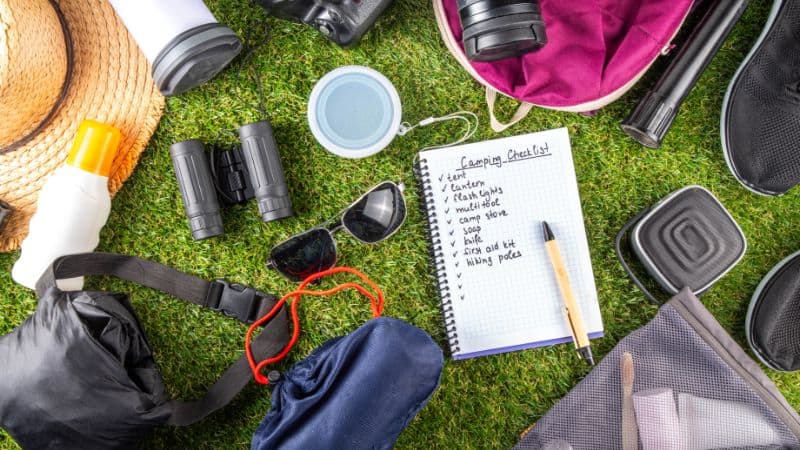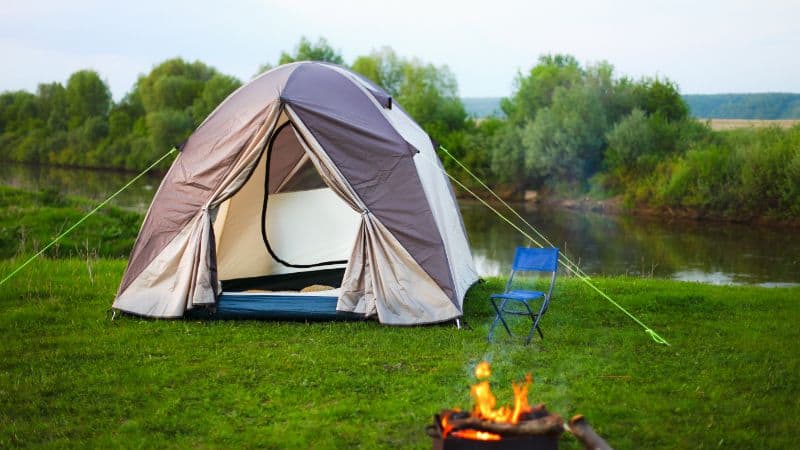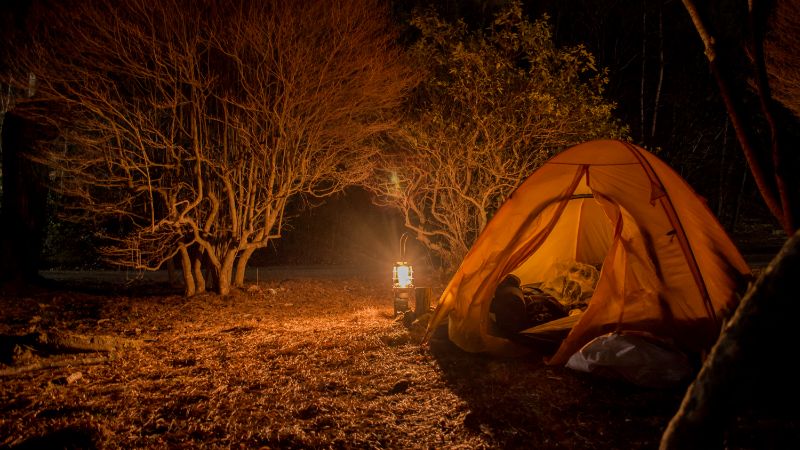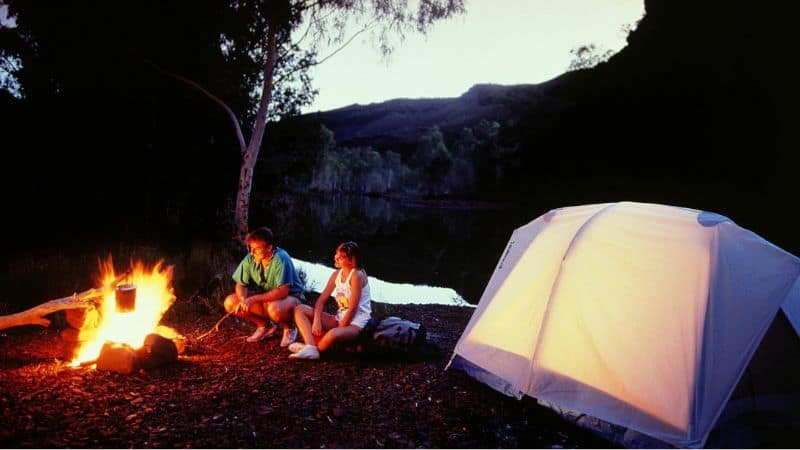Planning a camping trip? This simple checklist will help you pack smart and ensure your 2025 adventure is safe, comfortable, and full of great memories. With the right gear and preparation, you can relax and enjoy the beauty of the great outdoors without worrying about what you might have forgotten.

Packing the right equipment can make all the difference between a comfortable wilderness experience and a “never again” story. These essential items, organized by priority, will set you up for comfort, safety, and pure enjoyment, no matter your destination or the season.
1. Shelter & Sleep System: Camping Gear
Your primary defense against the elements and your sanctuary for rest.
- High-Quality Tent: This is your home away from home. Choose a tent big enough for your group plus some extra room for gear, and make sure it can handle the weather you expect.
- Tent Footprint/Groundsheet: A waterproof barrier placed under your tent. Protects your tent floor from getting wet and ripped.
- Sleeping Bags: Crucial for warmth and comfort. Get a sleeping bag that will keep you warm enough for the coldest nights you expect.
- Sleeping Pads/Air Mattresses: Insulation and cushioning. Keeps you warm by separating you from the cold ground and makes sleeping more comfortable.
- Camping Pillow: Often overlooked but greatly improves sleep. A small pillow makes a big difference in how well you sleep.
- Essential Shelter Accessories:
- Tent stakes (bring extras, suitable for different ground types)
- Guy lines (for stability in wind)
- Small mallet or rock for stakes
2. Illumination: Navigating the Night
Reliable Illumination: Navigating the Night Essential for safety, navigation, and convenience after sunset.
- Headlamps: For crucial hands-free lighting, consider the versatile and reliable Headlamps from MF Opto, offering various modes for any task.
- Flashlights: A dependable Flashlight is a must-have for general campsite use; MF Opto provides durable options.
- Camping Lanterns: To create a comfortable, well-lit campsite, explore Camping Lanterns by MF Opto, many with features like USB charging.
- Handheld Spotlights (Optional): For long-distance viewing, MF Opto’s Handheld Spotlights offer powerful illumination.
- Essential Accessories: Remember extra batteries or a power bank for your rechargeable lights.
3. Basic First Aid Kit for Camping Trip
- Comprehensive First Aid Kit: Pack a kit with supplies for common injuries:
- Adhesive bandages (various sizes, including knuckle and fingertip)
- Antiseptic wipes or solution (e.g., povidone-iodine or chlorhexidine)
- Sterile gauze pads (various sizes) and medical tape
- Butterfly bandages or wound closure strips
- Tweezers (for splinter/tick removal – learn proper tick removal technique)
- Small scissors
- Pain relievers (acetaminophen, ibuprofen)
- Antihistamines (for allergic reactions)
- Anti-diarrheal medication
- Moleskin or blister treatment pads (apply moleskin before a blister fully forms or use specialized hydrocolloid blister bandages on existing blisters)
- Burn cream or aloe vera gel
- Irrigation syringe (for cleaning wounds – use clean water)
- Elastic bandage (for sprains)
- Emergency blanket
- SAM splint (for potential sprains or fractures)
- Personal medications (ensure you have enough for the trip plus extra)
- Emergency contact information and a small first aid guide.
-
- Wound Cleaning: Clean wounds thoroughly with antiseptic wipes and rinse with potable water if available before bandaging to prevent infection.
- Storage: Store everything in a clearly marked, waterproof container.
- Maintenance: Check expiration dates before each trip and replace used or expired items promptly.
- Skills: Familiarize yourself with basic first aid procedures before your trip. Consider taking a Wilderness First Aid course for more comprehensive knowledge.
- Emergency Whistle: For signaling if lost or in distress.
- Navigation Tools:
- Map of the area (waterproof if possible)
- Compass (and know how to use it)
- GPS device or smartphone with GPS capabilities (and a power bank)
- Sun Protection:
- Sunscreen (broad-spectrum, SPF 30 or higher)
- Lip balm with SPF
- Sunglasses
- Wide-brimmed hat
- Insect Repellent: Choose one effective against ticks and mosquitoes in your area (e.g., DEET, Picaridin, or Oil of Lemon Eucalyptus).

4. Camping Kitchen & Cooking Must-Haves
Good food makes for happy campers.
- Camp Stove & Fuel: Reliable cooking power. A portable stove to cook your meals.
- Cookware & Utensils:
- Pots and pans (lightweight, nesting sets save space – consider aluminum or stainless steel)
- Plates, bowls, and cups (durable enamel, stainless steel, or BPA-free plastic)
- Eating utensils (sporks are a popular space-saver)
- Cooking utensils (spatula, large spoon, tongs)
- Sharp knife for food preparation (with a sheath for safety) and a small cutting board.
- Food & Water:
- Planned meals and snacks (pre-measure ingredients at home in reusable containers or zip-top bags to save time and reduce waste).
- Consider easy one-pot meals like chili, pasta dishes, or foil packet dinners.
- Sufficient drinking water (at least 1 gallon/4 liters per person per day) OR a reliable water filter/purification system and knowledge of local water sources.
- Collapsible water carrier or water jug for campsite use.
- Cooler (for car camping): For perishable items. High-performance coolers (e.g., Yeti, RTIC) offer extended ice retention. For longer trips, powered 12V coolers can be an option if you have a power source. Pack with block ice for longer-lasting cold.
- Cleaning Supplies:
- Biodegradable soap
- Sponge or scrub brush
- Collapsible sink or washbasin (optional)
- Trash bags (pack it in, pack it out!)
- Coffee/Tea Making Supplies: Instant coffee, pour-over filter and cone, lightweight French press, or tea bags.
- Waterproof Matches/Lighter/Ferro Rod: Reliable fire-starting methods.
5. Outdoor Clothing and Footwear Packing List
Layering is key to comfort in unpredictable outdoor weather.
- Layering System:
- Base Layer: Moisture-wicking (merino wool or synthetic fabrics like polyester – avoid cotton as it holds moisture).
- Mid-Layer: Insulation (fleece jacket/pullover, packable down or synthetic puffer jacket).
- Outer Layer: Waterproof and windproof (a breathable rain jacket with taped seams, e.g., Gore-Tex or similar, and rain pants).
- Strategy: Layering involves a base layer for moisture management, a mid-layer for insulation, and an outer layer for protection from wind and rain. Adjust layers as activity levels and weather change.
- Specific Clothing Items:
- Moisture-wicking underwear
- Moisture-wicking t-shirts (short and long-sleeved)
- Quick-drying pants and/or shorts (convertible pants are versatile)
- Extra socks (wool or synthetic blend – crucial for foot health)
- Sleepwear (dedicated dry clothes for sleeping)
- Hat for sun protection (wide-brimmed) and a warm hat for cold weather.
- Gloves or mittens (if cold weather is expected)
- Footwear:
- Hiking Boots/Shoes: Broken-in, sturdy footwear with good ankle support and traction suitable for the terrain.
- Camp Shoes: Comfortable shoes for relaxing around camp (e.g., sandals, sneakers).

6. Tools & Repair Kit: The Campsite Essentials
Be ready for minor repairs and campsite tasks.
- Multi-Tool or Pocket Knife: Indispensable for countless tasks. A versatile tool with a knife, screwdrivers, etc.
- Paracord/Rope: At least 50 feet for clotheslines, securing gear, bear bags (where required), etc.
- Duct Tape: Wrap some around a water bottle or trekking pole to save space.
- Zip Ties: For quick fixes.
- Small Repair Kit:
- Tent pole splint/sleeve
- Fabric patches for tent and sleeping pad (e.g., Tenacious Tape)
- Seam sealer for tents
- Needle and heavy-duty thread
- Folding Saw or Hatchet (if campfires are permitted & you’ll process wood): Always check fire regulations first.
- Small Shovel or Trowel: For digging catholes (6-8 inches deep, 200 feet from water, trails, and camp) or managing campfires.
- Whisk Broom and Dustpan (small): For keeping the tent clean.
7. Personal Items & Toiletries: Comfort and Hygiene
Maintain hygiene and personal comfort.
- Toiletries:
- Toothbrush and toothpaste (travel size)
- Biodegradable soap and shampoo (use sparingly and away from water sources)
- Quick-dry microfiber towel
- Deodorant
- Hand sanitizer
- Toilet paper (in a waterproof bag)
- Feminine hygiene products (if needed)
- Camp Accessories for Comfort:
- Camp chairs
- Small portable table (optional)
- Book or entertainment
- Camera
- Portable power bank for charging electronics
What Should You Not Bring Camping Outdoors?
Knowing what to leave behind is as important as knowing what to pack. Overpacking adds unnecessary weight and clutter.
- Electronics and Valuables (Excessive): Laptops, tablets, expensive jewelry. They risk damage and detract from the experience. A phone (for emergencies and photos) and perhaps an e-reader are usually sufficient.
- Fragile Items: Glass bottles or containers. Opt for plastic, metal, or silicone alternatives.
- Strongly-Scented Toiletries or Perfumes: These can attract wildlife, including bears and insects. Choose unscented or mildly scented biodegradable options.
- Excessive or Inappropriate Clothing: Skip the fashion items. Pack practical, layerable, weather-appropriate clothing.
- Noisy Devices: Large speakers, generators (unless medically necessary and permitted). Respect fellow campers and the tranquility of nature.
- Lots of Cash: Bring enough for fees or small purchases, but avoid carrying large amounts.
- Heavy Books: One lightweight paperback or an e-reader is better.
- Fireworks or Firearms (unless specifically permitted and trained): Check local regulations.
Remember, camping is about simplifying and connecting with the natural world. Items that distract from this or could cause environmental harm are best left at home.

Adapting Your Checklist: 3, 5, & 7+ Days of Camping
While the core essentials remain, trip duration influences quantities and specific needs.
| Trip Length | Food Planning | Water Needs (per person) | Special Considerations |
| 3 Days | Approx. 9 meals + snacks | Approx. 3 gallons (or filter) | Basic supplies suffice. One well-packed cooler may manage perishables. |
| 5 Days | Approx. 15 meals + snacks | Approx. 5 gallons (or filter) | More comprehensive first aid. Consider camp hygiene more carefully (e.g., solar shower, more soap). Laundry soap for essentials. |
| 7+ Days | 21+ meals (focus on non-perishable) | Reliable water filtration system | Extended first aid, comprehensive gear repair kit (tent pole splint, fabric patches, seam sealer), camp maintenance tools. |
Essential General Camping Tips for a Smooth Trip
- Check the Weather, Then Check Again: Pack layers to adapt.
- Arrive Early: Setting up camp in daylight is far easier and safer.
- Test Gear at Home: Ensure your tent, stove, and lights are functional before you’re in the wilderness.
- Stay Hydrated: Drink water regularly, even if you don’t feel thirsty.
- Food Storage Savvy: Keep food in airtight containers. Store away from your tent, using bear lockers or bear bags where required, to prevent wildlife encounters.
- Share Your Itinerary: Let someone reliable know where you’re going and when you expect to be back.
- Leave No Trace: This is paramount.
- Plan ahead and prepare.
- Travel and camp on durable surfaces.
- Dispose of waste properly (pack it in, pack it out).
- Leave what you find.
- Minimize campfire impacts (use existing rings, keep fires small, ensure fully extinguished).
- Respect wildlife (observe from a distance, never feed animals).
- Be considerate of other visitors.
- Know Local Regulations: Check for fire bans, wildlife advisories, and specific campsite rules.
Your Adventure Awaits!
We hope this ultimate camping checklist helps you prepare for an unforgettable 2025 outdoor adventure! Proper planning transforms a good camping trip into a great one, filled with joy, discovery, and lasting memories.






